What you need to pay attention to when buying a blender and how to choose the right model for your home
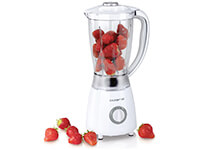 The question of choosing a blender is of interest to modern housewives who prefer to have a variety of appliances in the kitchen.
The question of choosing a blender is of interest to modern housewives who prefer to have a variety of appliances in the kitchen.
Various types of devices from leading domestic and foreign manufacturers are widely represented on the Russian market.
To select the best option, it is necessary to determine the real needs in terms of the number and range of prepared dishes.
It is important to determine the main criteria and choose the most high-quality model.
Rating of the TOP 5 best blenders 2024-2025 of the year
| Place | Name | Price |
| Rating TOP 5 best blenders | ||
| 1 | Bosch MSM 87165 | Ask for a price |
| 2 | Braun MQ 5037 WH Sauce+ | Ask for a price |
| 3 | Moulinex DD655832 | Ask for a price |
| 4 | Xiaomi Circle Kitchen CD-BL01 | Ask for a price |
| 5 | Philips HR1679 Avance Collection | Ask for a price |
Content
- Rating of the TOP 5 best blenders 2024-2025 of the year
- Why do we need a blender and how it works
- Types and their brief description
- Which is better - submersible or stationary?
- How to choose a good model for your home?
- What parameters should I pay attention to before buying?
- Rating TOP 5 best blenders
- Conclusion and Conclusions
- Useful video
Why do we need a blender and how it works
Basically, a blender is a scaled-down food processor.
At first he wondered how apparatus for mixing liquid and soft products (primarily for making cocktails), and therefore the name itself comes from the word "mix".
Modern appliances combine the functions of a blender as a mixer, mixer and chopper (coffee grinder). They easily cope with such operations as mixing, whipping, cutting and grinding products of different hardness and consistency.
With their help, cocktails, smoothies, purees, mousses, creams, dough and many other dishes are prepared.
The working container is filled with the processed product. The nozzle is set in rotation, involving the entire mass in motion. Depending on the type of nozzle and rotation speed, the desired operation is provided - cutting, mixing, rubbing, whipping.
Types and their brief description
Depending on the method of introducing the working body into the processed mass and providing power, blenders are divided into the following types:
- Immersion construction. It provides for the location of the working body in the upper part of the container with the product. Such a blender is a housing with a built-in electric motor. The shaft is brought out from below, and the desired nozzle is fixed on it. The body is equipped with a handle for holding in the hand. The device is manually inserted from above into the tank with the processed mass and is driven into rotation.
- Stationary option. His working body is located at the bottom of the tank. The blender consists of a base (case) with an electric motor and a bowl that is installed on the base. The motor shaft is inserted into the bowl from below, and nozzles are fixed on it. A splash guard is fitted on top.Such a blender is permanently installed on the table, and after switching on it does not require the direct participation of a person in the process. The operation is provided automatically.
- Combined type. Some modern devices combine the above options. In fact, this is a stationary chopper, but additionally there is an immersion blender for mixing and whipping.
Which is better - submersible or stationary?
A comparison of the main parameters will help you choose the right type of blender. Such an analysis is carried out in the table.
Comparison of submersible and stationary blender design:
| Characteristic | Submersible type | Stationary type |
|---|---|---|
| Power | Devices with a power in the range of 200-1400 W are produced | Up to 2.5 kW. The power is higher, which ensures the grinding of products of any hardness and the preparation of significant volumes. |
| Functionality | The main purpose is whipping and mixing mixtures. Can grind not very hard products. Not good for making cocktails. | Provides crushing of products of the increased hardness (nuts, coffee, ice, etc.). You can cook liquid dishes (soup-puree). Not suitable for whipping. |
| Working volume, productivity | You can prepare portions of less than 200 ml. The disadvantage is the restriction on the maximum volume (most often - 1 l) | The minimum portion is 250-300 ml.There is a possibility of preparation of considerable volumes when using big bowls (2-3 l). Productivity is higher than that of submersible models. |
| Ease of use | Plus, complete control of the process. Possibility of using non-standard capacity. Minus - the need to hold in hand and constant participation in the process. | Automation of the process, no need for direct human participation after switching on. Process programming. |
| Dimensions and weight | Small dimensions and weight of the device | Increased sizes. Need storage space |
| Care | Ease of maintenance. Washable only nozzles that can be easily removed. | Washing requires complete disassembly. This disadvantage is eliminated by the presence of a self-cleaning function. |
| Reliability | Hard ingredients can cause wear and damage to tips. Limited motor protection capabilities. Significant dependence on correct use. | Increased reliability and durability. Guaranteed engine protection. Automatic shutdown in case of incorrect operation. |
| Price | Depends on power, but on average higher than stationary models | Lower combined power-price. |
How to choose a good model for your home?
How to choose a good blender for home?
First of all, it should be understood that an increase in power, size and functionality leads to a noticeable increase in the cost of equipment. When buying, you will have to solve the main issue - maximum satisfaction of the request at the lowest price.
Do not skimp on reliability and safety. It is best to purchase products from trusted manufacturers and made from quality materials (especially knives and other attachments).
Another thing is functionality and performance. This issue should be approached based on real needs. Do not pay attention to functions that will not be useful, or the possibility of cooking dishes that will not be useful.
Portions should be appropriate for the family composition. So, the most popular devices are for making cocktails, smoothies, creams, purees, sauces, whipping cream and eggs for omelets, grinding minced meat and coffee beans.
Blenders are a must for athletes and young mothers. For those who like to travel, portable models are suitable.
With frequent use and cooking in large quantities, professional and professional devices are of interest.
What parameters should I pay attention to before buying?
When choosing a blender, you should take into account the main parameters that determine the reliability and capabilities of the device.
For different models, they differ significantly, and therefore, before buying, you must carefully read the technical characteristics and operating instructions. The following selection criteria are commonly used.
Power
The performance and functionality of the device is largely determined by the power of its electric motor. It can vary over a wide range from 120 W (portable devices) to 2.6-3 kW (professional devices).
When choosing, you can focus on the following recommendations:
- using devices up to 250 W, you can make cocktails;
- power 220-360 W is sufficient for baby puree, mixing soft and liquid foods;
- blenders with a power of 350-650 W cope with not too hard products - whipping, cooking pasta, jams, smoothies, minced meat, etc.;
- a power of 0.7-1 kW will be required to crush ice and grind coffee beans or walnuts;
- devices of the order of 1-1.2 kW cope with the kneading of thick dough;
- with a power of more than 1 kW, products of almost any hardness are crushed.
For most culinary activities, a power of 0.6-0.8 kW is quite sufficient. For this reason, such blenders enjoy the greatest popularity.
Speed mode
For the processing of different products, different speeds of rotation of the working body are required.
The minimum speed is required for milkshakes and purees. To grind nuts and vegetables, a medium speed range is suitable, and the fastest rotation is useful for dough and minced meat. In addition, the speed of cooking also depends on the speed mode.
For most operations, it is enough to have 2-3 speeds, but with an expanded range of dishes, devices with 5-8 modes are more suitable. More than 10 speeds are required for professional use.
Modern blenders can have up to 30 different speed settings. It is important that the speed has a smooth adjustment within the same mode.
Most blenders have the following operating modes:
- working, with adjustable speed;
- turbo mode - work immediately at maximum speed after switching on;
- pulse - periodic switching on and off of the device.
Knives and attachments
The number of nozzles in the set of the device determines the functionality. Good blenders have 3-5 different attachments.For some of them, separate bowls are provided (the kit may include 2-3 containers).
Knives require special attention.
The following details are taken into account:
- Number of blades. They can be from 2 to 6.
- The form. The simplest knives are straight and cut food well. High-quality grinding and homogeneous mixing are provided by curved elements.
- Material. Reliable knives are made of stainless steel.
Material
When choosing a model, you need to find out what the body and bowl of the blender are made of. The case can be plastic, metal or combined. Metal is more durable, but it is also more expensive than plastic. Modern plastics can be worthy of competition.
More important is the question of the material for the bowls. Glass or plastic can be used here.
The first option looks preferable due to transparency, heat resistance, chemical inertness and high wear resistance. However, glass is more expensive and fragile.
Plastic bowls can quickly scratch, which spoils the appearance. They cannot be used for hot food. Ecological cleanliness is also questionable. In modern models, a new material is used - tritan, which can adequately replace glass.
Useful volume
The performance of the blender depends on the volume of the working container. If any vessels can be used in submersible structures, then the design of its bowl is important for stationary models. In this case, it should be borne in mind that its useful volume is taken 150-200 ml less than the geometric one.
The volume of the bowl is selected based on the need for the finished product. Mini blenders have capacities of 150-300 ml.The most common devices are equipped with bowls of 0.5-0.8 liters. For large families, a volume of 1-1.5 liters is required. In professional devices, jugs up to 2-2.5 liters are provided.
Nozzle set
The blender kit may include the following attachments:
- Knives. These are the most common attachments that come with all blenders. With their help grinding, cutting and hashing of a product is provided. In a stationary device, they are fixed at the bottom of the bowl. For submersible models, a knife on a leg (made of plastic or metal) is used.
- Corolla. It is used in immersion blenders for whipping. The highest quality nozzles are made of stainless steel wire.
- Puree attachment. It is made of plastic and provides airiness and uniformity of mass.
- chopper. This is a separate bowl in which a special nozzle is installed (chopper, graters, slices, nozzle for cutting slices and cubes). Separately, there is such a type of grinder as a grinder for coffee beans. This bowl has a small volume (50-100 ml). The most common version of the chopper with a chopper knife.
- Ice Crusher. It is simply necessary for the preparation of cold drinks.
- shredder. The nozzle is designed for fine cutting of fruits, vegetables, cheese, etc.
In universal devices, additional nozzles (hooks for dough, knives for curly cutting, etc.) may be provided.
When buying a blender, you should realistically assess the need for a large number of attachments. They increase the cost and complicate the work. Standard knives handle the absolute majority of work, and it is enough to have another whisk and grinder to provide all the needs.
Additional functions
Some blenders have the following features:
- overheat protection. This is a very necessary function, provided by the installation of special sensors, and an automatic shutdown system. It allows you to protect the engine from emergency operation.
- vacuum mode. It consists in pumping air out of the bowl during certain operations with the product. This eliminates the oxidation of the ingredients during mixing and grinding. A blender with this function provides a special vacuum pump and a sealed container.
- Self cleaning. This function is provided in modern stationary models. It consists in cleaning the device after use by pouring a small amount of water.
Doubtful additional features are also advertised in a number of installations:
- Noise suppression. It is needed at a noise level of more than 70 dB, and modern devices have much less noise.
- Steam cooking. In practice, it shows low efficiency and inconvenience.
- Wall mounting. More often than not, this versatility is not needed.
:
Rating TOP 5 best blenders
It is very difficult to navigate in the vast sea of proposals. In order to choose the really best option, you should take into account the rating of the best models.It is compiled on the basis of numerous customer reviews and expert assessments of specialists. Below is the TOP 5 for 2019.
Bosch MSM 87165
One of the leaders in the ranking is the Bosch MSM 87165 blender. This submersible has a power of 0.75 kW.
Number of speed modes - 12. Smooth adjustment. Mechanical control. The volume of the glass is 0.6 l. Weight - 1.8 kg.
It is worth noting that this is one of the best models of 2024-2025.
pros
- Ease of controls;
- a large number of modes;
- a sufficient number of attachments (including for puree);
- high strength knives.
Minuses
- complaints about the length of the power cord;
- significant mass.
In this device, high build quality and reliability are especially noted.
Braun MQ 5037 WH Sauce+
Buyers give one of the first places in the TOP to the Braun MQ 5037 WH Sauce + blender.
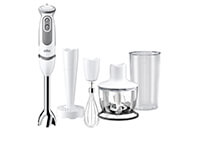
pros
- high reliability;
- affordable price;
- a large selection of speed modes;
- reliable shredder.
Minuses
- buyers do not report defects.
Moulinex DD655832
The submersible model Moulinex DD655832 enjoys well-deserved popularity.
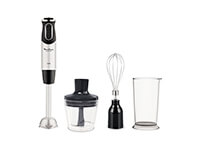
pros
- increased power;
- all necessary nozzles are included;
- reliable knives;
- high quality grinder and whisk.
Minuses
- short cord length;
- significant mass.
A high rating ensures the reliability and safety of the device.
Xiaomi Circle Kitchen CD-BL01
Consumers and professionals highlight the Xiaomi Circle Kitchen CD-BL01 blender. This is a miniature stationary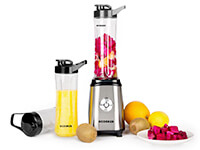
There is 1 speed mode with smooth adjustment. Includes 2 travel bottles of 0.3 and 0.6 liters. The set has no frills.
pros
- miniaturization and light weight;
- low cost;
- high rotation speed;
- reliability.
Minuses
- low power;
- only 1 mode.
Disadvantages limit functionality, but in its class it is a unique device. It is perfect for making cocktails and smoothies, preparing small portions of other dishes. Price - 1910 rubles.
Philips HR1679 Avance Collection
The recognized leader is the Philips HR1679 Avance Collection blender. This is a submersible type model with a power
The grinder has a bowl on 2 l. A 1 liter measuring cup is provided. There are functions for crushing ice and dicing. The grinder with a capacity of 0.3 liters qualitatively grinds coffee beans.
This model has proven itself well in 2024-2025.
pros
- multifunctionality;
- a large number of nozzles;
- high performance.
- proprietary speed control system.
Minuses
- deficiencies were not found.
A high rating ensures reliability and ease of management.
Conclusion and Conclusions
Currently, blenders have become real assistants to the hostess in the kitchen.
The market offers a variety of models for every taste. It is important to correctly assess your own needs and capabilities, and based on them, choose the best option according to the main criteria.Particular attention should be paid to the manufacturer of equipment.
Useful video
Tips for choosing a blender:




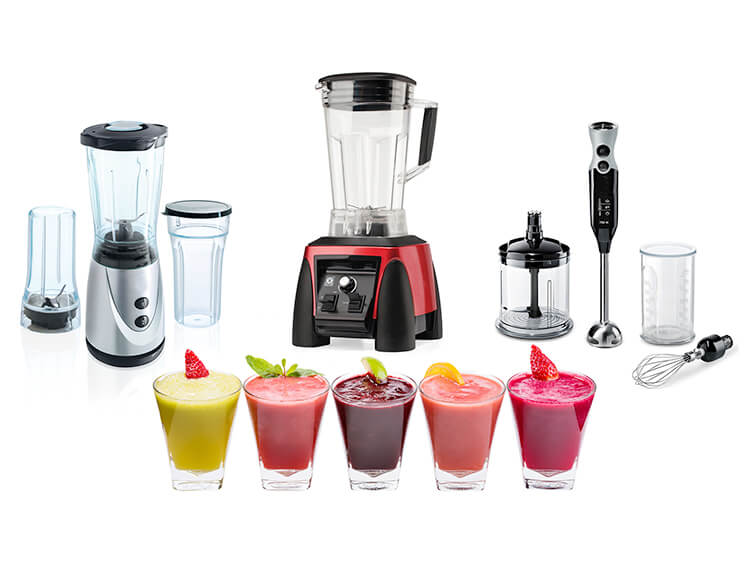
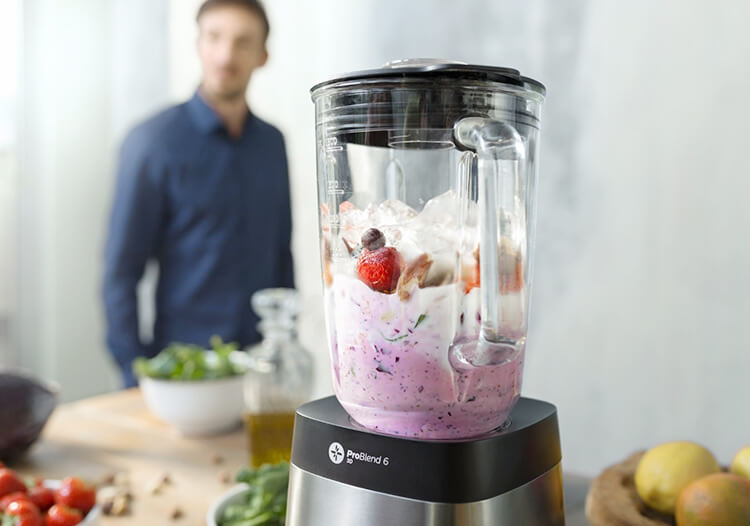
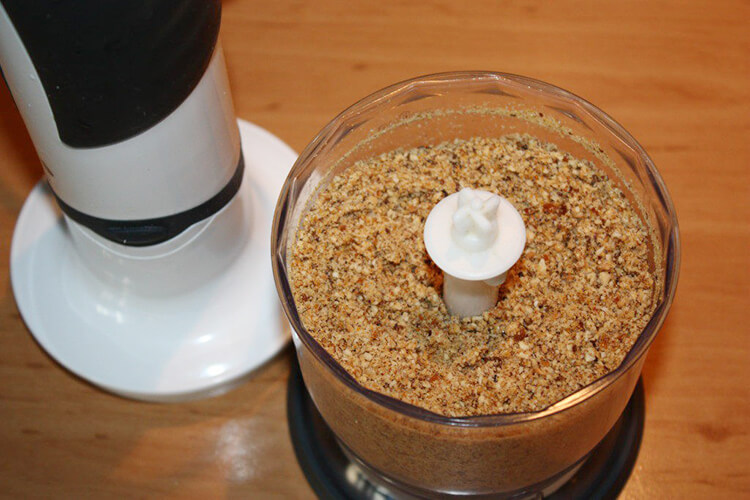
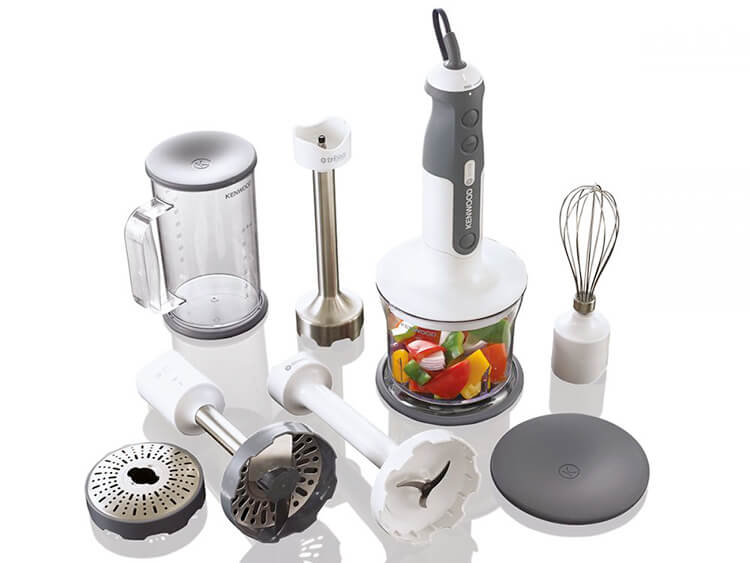
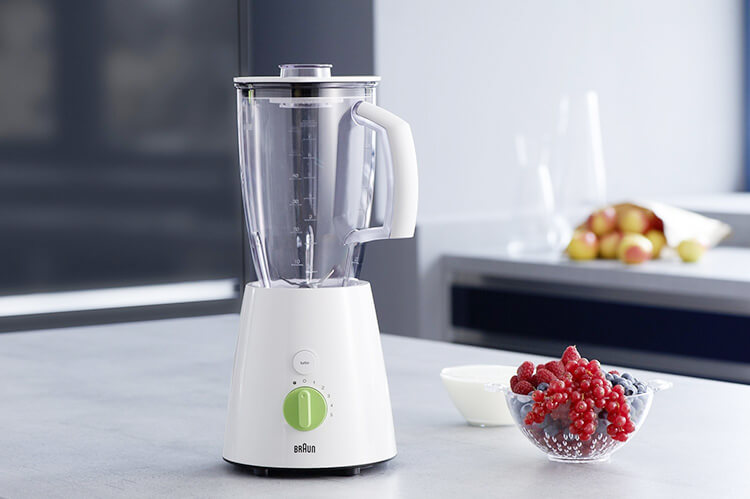
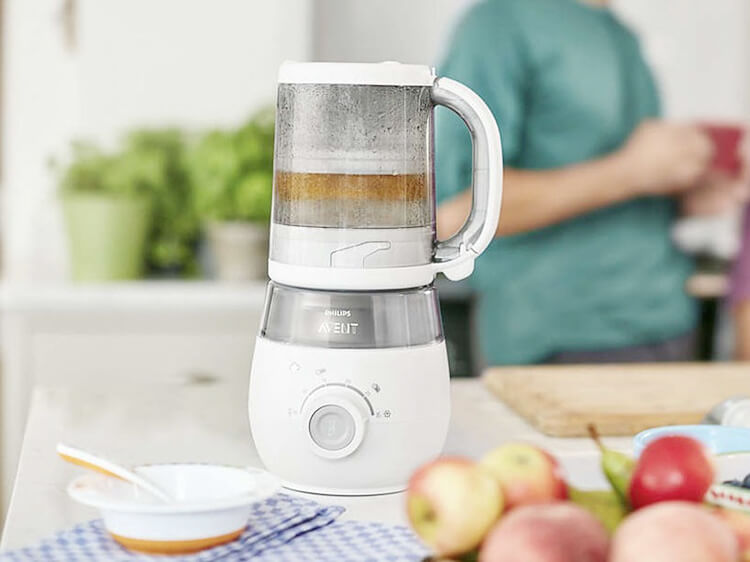
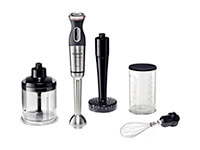
When choosing a blender, you need to look at the appearance. The presence of defects on the body. The integrity of the braid of the electrical cord. Sharpening, and nicks on knives. Completeness and correct filling of sales documents. If everything matches, there is hope for a long blender operation.
Submersible blender, it is better to take with a metal working part. It provides a longer service life, and exposes the product to breakage (breaking) less. The number of speeds also matters. Choose better known brands, since the engine and associated components are better finalized. Pay attention to counterfeit firms under well-known brands. They make the name consonant with leading brands.
When I chose a blender, of course, at first I paid attention to the fact that it would have a good appearance, its power and durability, considering what operations I will perform with it. And I chose Bork for myself, I liked the fact that it can even grind meat, which was important for me.
I have been fond of cooking for a long time, I make unique sweets from nuts and dried fruits. So, practice has shown that it is necessary to take the most powerful blender possible, no less than 800 watts. A simpler one will still quickly fail. Plus, you need a powerful bowl with thick walls.
I want to give myself a blender for the new year. I don’t have a big bag, on the basis of this parameter I chose a device for myself. I even put one in the basket in the online store. But then I came across this article and realized that my choice was bad. I’d rather add a little money and buy a good and proven option in accordance with the recommendations.
In a short time, within six months, two submersible blenders became unusable - it was Supra (something burned out) and Delta (Russian-made, which I was offered instead of Supra). Delta's incisors (inserts) have worn out. The plastic bowls were streaked and cloudy on both of them.But the stationary Bosh with a very thick shot bowl turned out to be of very high quality - I’m not overjoyed. In general, I do not recommend a plastic bowl in any of the models.